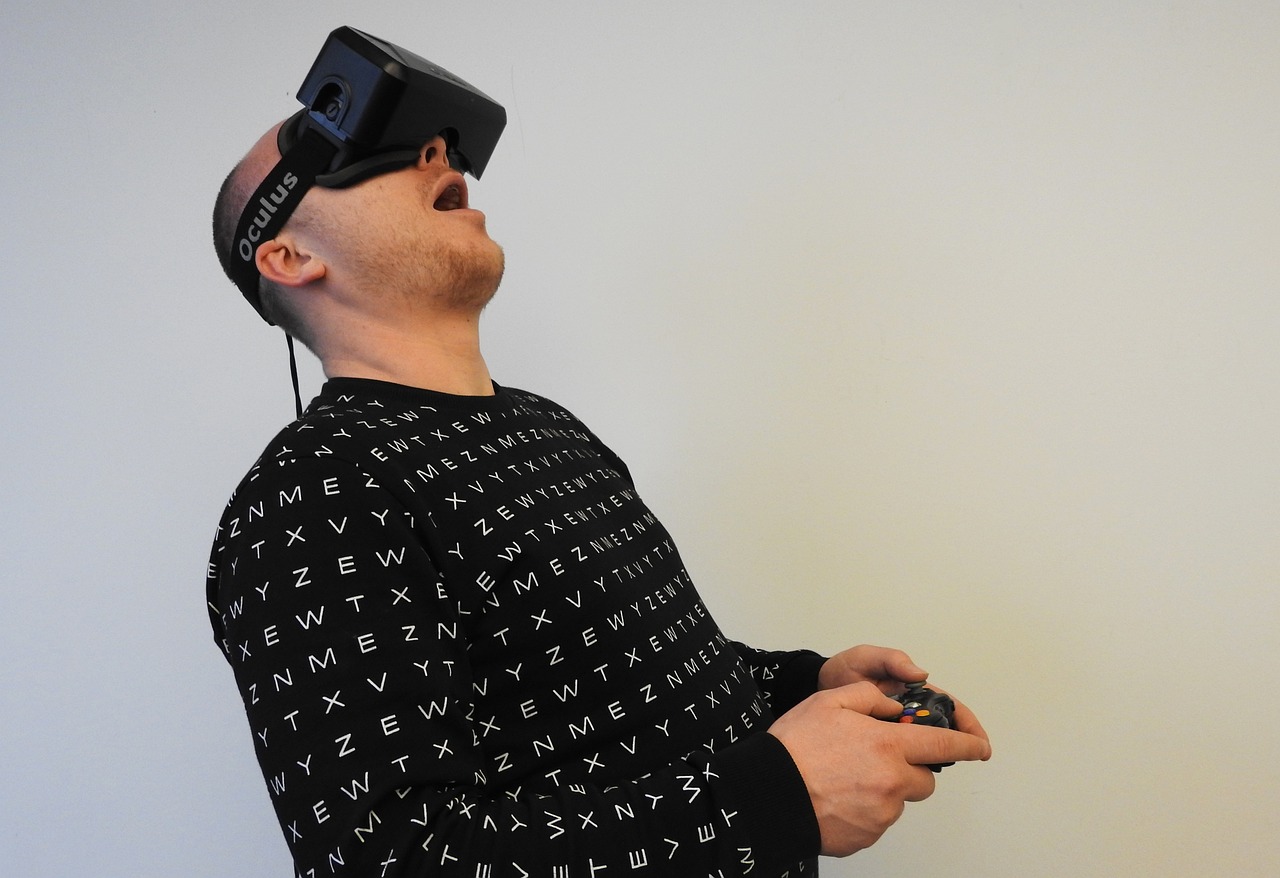Assessing the Effectiveness of VR for Joint Task Force Training
In today's fast-paced world, where technology reigns supreme, virtual reality (VR) has emerged as a game-changer in various fields, and military training is no exception. Imagine a scenario where soldiers can engage in realistic combat situations without ever stepping foot on a battlefield. This is the promise of VR technology, which is revolutionizing how joint task forces prepare for real-world operations. As we delve deeper into the effectiveness of VR for training, we'll explore its benefits, challenges, and the overall impact on military preparedness and operational success.
VR technology is being seamlessly integrated into military training programs, creating an environment where soldiers can experience realistic simulations that enhance their learning and operational readiness. Think of it as a high-tech playground for soldiers, where they can practice their skills in a safe yet challenging environment. The immersive nature of VR allows trainees to engage in complex scenarios that mimic real-life situations, thereby bridging the gap between theory and practice. This innovative approach not only boosts confidence but also improves teamwork and communication among joint task forces.
When it comes to training, VR offers a plethora of advantages that traditional methods simply can't match. For starters, it's cost-effective. While the initial investment in VR technology may seem steep, the long-term savings on travel, equipment, and live training exercises can be significant. Additionally, VR training ensures safety by allowing soldiers to practice high-risk maneuvers without the fear of injury. This is particularly crucial in military operations, where the stakes are incredibly high.
One of the standout features of VR training is its ability to create immersive environments that transport trainees into scenarios that feel incredibly real. Imagine being able to navigate through a dense forest while under simulated enemy fire, or coordinating a rescue mission in an urban setting—all without leaving the training facility. This level of immersion significantly improves decision-making and situational awareness, as trainees are forced to think on their feet and adapt to rapidly changing circumstances.
VR excels at simulating high-pressure environments, allowing trainees to practice their responses to stress and uncertainty. In a world where split-second decisions can mean the difference between success and failure, this training is invaluable. By replicating the chaos of combat, soldiers can learn to maintain their composure and execute their training under pressure. The beauty of VR is that it provides a safe space for failure, enabling soldiers to learn from their mistakes without real-world consequences.
Another significant advantage of VR training is its customizability. In traditional training, scenarios can sometimes feel one-size-fits-all. However, with VR, instructors can design tailored training experiences that meet the specific needs of different units within a joint task force. Whether it's a counter-terrorism operation or a humanitarian mission, the flexibility of VR allows for a wide range of scenarios that can be adjusted in real-time based on the trainees' performance and learning objectives.
Despite its many benefits, implementing VR technology in military training does come with its challenges. For one, there are technical limitations that can hinder the effectiveness of VR training. Not all military facilities are equipped with the necessary technology, and the cost of upgrading can be a barrier. Additionally, there is a need for specialized training for instructors to ensure that they can effectively use VR tools and techniques. This can lead to an initial learning curve that may slow down the integration process.
To truly understand the impact of VR training, it's essential to measure its effectiveness. Various methods can be employed to assess how well VR training programs are achieving their objectives. Performance metrics, feedback from trainees, and long-term operational outcomes can all provide valuable insights into the success of VR training initiatives.
Gathering feedback from participants is crucial in ensuring that VR training meets its desired objectives. Tools such as surveys, performance assessments, and debriefing sessions can help instructors gauge the effectiveness of the training. By analyzing this feedback, military organizations can make necessary adjustments to improve the training experience and outcomes.
Studies have shown that VR training can have a lasting impact on military performance and readiness. By examining data from joint task force missions, researchers can illustrate how VR training contributes to operational success. The ability to prepare soldiers for real-world scenarios through immersive training not only enhances their skills but also boosts their confidence, ultimately leading to better performance in the field.
- What is VR training? VR training involves the use of virtual reality technology to create simulated environments for military training purposes.
- How does VR improve military training? VR enhances training by providing realistic scenarios, improving decision-making, and allowing for safe practice of high-stress situations.
- What are the challenges of implementing VR in military training? Challenges include technical limitations, costs, and the need for specialized instructor training.
- How is the effectiveness of VR training measured? Effectiveness can be measured through performance metrics, trainee feedback, and long-term operational outcomes.

The Role of VR in Military Training
Virtual Reality (VR) has emerged as a revolutionary tool in military training, reshaping how joint task forces prepare for real-world operations. Imagine stepping into a digital world where you can engage in realistic combat scenarios without the risks associated with live training exercises. This is the power of VR. It immerses soldiers in lifelike environments, enabling them to practice tactics, decision-making, and teamwork in a safe yet impactful manner. As military strategies evolve, the integration of VR technology into training programs becomes not just beneficial, but essential.
One of the standout features of VR in military training is its ability to provide realistic simulations. Traditional training methods often rely on physical drills and classroom instruction, which can limit the scope of what soldiers experience. VR breaks these barriers by creating environments that replicate the complexities of modern warfare. From urban combat scenarios to natural disaster responses, VR can simulate a myriad of situations that soldiers may encounter in the field. This not only enhances their operational readiness but also builds confidence in their skills.
Moreover, VR training is designed to be adaptive. It allows trainers to modify scenarios on-the-fly, tailoring exercises to the specific needs of different units. For instance, a unit specializing in urban warfare can engage in simulations that focus on close-quarters combat, while another unit can practice large-scale maneuvers in a rural setting. This customization ensures that each soldier receives the training most relevant to their roles, enhancing the overall effectiveness of joint task forces.
Additionally, the immersive nature of VR fosters team cohesion. Soldiers can train together in a shared virtual space, promoting communication and collaboration. This is particularly crucial in joint task forces, where multiple branches of the military must work seamlessly together. The ability to rehearse missions in a virtual environment helps to break down silos and build trust among team members, ultimately leading to more effective operations in real-life scenarios.
However, the role of VR in military training is not just about technology; it’s about transforming the way soldiers learn. With VR, the learning experience becomes interactive and engaging, moving away from passive observation to active participation. This shift is vital because studies have shown that experiential learning leads to better retention of information and skills. Soldiers are not just memorizing procedures; they are living them, which significantly enhances their preparedness for actual missions.
In summary, the integration of VR into military training programs is a game-changer. It provides realistic, adaptive, and immersive training experiences that prepare joint task forces for the complexities of modern warfare. As technology continues to advance, the potential for VR in military applications will only grow, making it an indispensable tool for enhancing military readiness and operational success.

Benefits of VR Training
When it comes to military training, the stakes are incredibly high. Traditional methods, while effective, often fall short in replicating the complexities of real-world scenarios. Virtual Reality (VR) technology steps in as a game-changer, offering a plethora of benefits that can significantly enhance the training experience for joint task forces. Imagine being able to step into a fully immersive environment where you can practice everything from tactical maneuvers to crisis management without any real-world risks. Sounds like a dream, right? Well, it's becoming a reality!
One of the most compelling advantages of VR training is its cost-effectiveness. While the initial investment in VR technology can be substantial, it often pays off in the long run. Consider the costs associated with live training exercises—fuel, equipment wear and tear, and even potential medical expenses from injuries. VR eliminates many of these costs by allowing troops to train in a safe, controlled environment. Moreover, it can be accessed repeatedly, making it a sustainable option for continuous training.
Safety is another critical concern in military training. With VR, trainees can engage in high-stakes scenarios without the risk of physical harm. For instance, they can practice navigating through hostile territories or managing equipment failures under pressure. This kind of training not only builds confidence but also fosters a culture of safety within the unit. Imagine a soldier who has faced a simulated explosion multiple times; when a real situation arises, their mind is already trained to react appropriately, reducing the likelihood of panic.
Furthermore, VR offers the unique ability to replicate complex scenarios that traditional methods may struggle to provide. For example, joint task forces often operate in multifaceted environments where multiple units must coordinate their actions effectively. VR can simulate these intricate scenarios, allowing soldiers to practice their roles in real-time, enhancing their teamwork and communication skills. This level of preparation is invaluable when lives are on the line.
Another standout benefit of VR training is the enhanced realism and immersion it provides. Imagine donning a VR headset and finding yourself in a lifelike battlefield, complete with sounds and visuals that mimic the chaos of combat. This immersive experience significantly improves decision-making and situational awareness. Trainees are not just passively absorbing information; they are actively engaging with their environment, which leads to better retention of skills and knowledge.
One of the most powerful aspects of VR is its ability to simulate high-stress situations. In traditional training, it can be challenging to replicate the pressure of a real combat scenario. However, VR can create environments where trainees face time-sensitive decisions and unexpected challenges. This prepares them to handle stress and uncertainty effectively. Think of it as a high-stakes video game where the consequences are real, but the environment is controlled. Trainees can practice their responses without the fear of real-world repercussions, making mistakes in a safe space where they can learn and grow.
Customization is yet another advantage of VR training. Each unit within a joint task force has unique needs and operational goals. With VR, training scenarios can be tailored to meet these specific requirements. For instance, if a unit specializes in urban warfare, they can engage in simulations that focus on navigating city landscapes, dealing with civilian interactions, and managing urban-specific threats. This flexibility ensures that every training session is relevant and effective, allowing for a more targeted approach to skill development.
In conclusion, the benefits of VR training for joint task forces are clear. From cost savings and safety to enhanced realism and customization, VR is revolutionizing how military personnel prepare for their missions. As technology continues to advance, we can expect even more innovative applications that will further improve military readiness and operational success.

Enhanced Realism and Immersion
One of the most striking features of Virtual Reality (VR) technology is its ability to create environments that feel incredibly real. Imagine stepping into a battlefield simulation where every sound, sight, and sensation is meticulously crafted to mimic reality. This level of realism and immersion is not just a gimmick; it serves a crucial purpose in military training. By providing trainees with lifelike experiences, VR helps them develop critical skills that are essential for success in joint operations.
In traditional training methods, soldiers might engage in drills that lack the intensity and unpredictability of real combat. However, with VR, they can navigate through complex scenarios that demand quick thinking and adaptability. The immersive nature of VR means that trainees are not just passively observing; they are actively participating in the experience. This engagement leads to improved decision-making and situational awareness, as they learn to assess threats and respond effectively under pressure.
To illustrate the impact of enhanced realism, consider the following aspects of VR training:
- Visual Fidelity: High-definition graphics and realistic animations create a convincing environment that closely resembles real-life situations.
- Sound Design: Immersive audio, including directional sounds and ambient noise, enhances the training experience by providing auditory cues that are crucial in combat scenarios.
- Physical Feedback: Advanced haptic technology allows trainees to feel the recoil of a weapon or the impact of an explosion, further bridging the gap between simulation and reality.
The ability to simulate high-stress situations is another significant advantage of VR. Trainees can experience the chaos and unpredictability of combat without the associated risks. For instance, they might find themselves in a scenario where they must make split-second decisions while under fire. This practice not only builds their confidence but also conditions them to maintain composure in real-life situations where the stakes are incredibly high.
Furthermore, VR allows for customizable training scenarios. Instructors can design specific missions tailored to the unique needs of different units, ensuring that each training session is relevant and challenging. This flexibility means that whether a unit is preparing for urban warfare or counter-terrorism operations, they can train in an environment that mirrors their upcoming challenges.
In summary, the enhanced realism and immersion provided by VR technology are revolutionizing military training. By creating lifelike scenarios that engage trainees on multiple sensory levels, VR not only prepares soldiers for the realities of combat but also enhances their overall effectiveness in joint task force missions. As this technology continues to evolve, the possibilities for its application in military training are virtually limitless.

Simulation of High-Stress Situations
When it comes to military training, the ability to simulate high-stress situations is not just beneficial; it's essential. Think about it: in real-world combat, soldiers often face intense pressure, making split-second decisions that can mean the difference between success and failure. Traditional training methods, while valuable, often fall short in replicating the chaotic and unpredictable nature of actual combat. This is where virtual reality (VR) shines, offering a dynamic platform that immerses trainees in scenarios that mimic the rigors of real-life operations.
Imagine being placed in a VR environment where the sounds of gunfire echo around you, smoke fills the air, and the urgency of a mission weighs heavily on your shoulders. This immersive experience allows soldiers to train in a safe environment where they can make mistakes without real-world consequences. The psychological benefits are profound; by experiencing simulated stress, trainees can learn to manage their reactions, hone their decision-making skills, and build resilience. They can practice techniques to maintain composure and focus, which are crucial in high-stakes situations.
Moreover, VR can replicate a wide variety of scenarios, from urban warfare to hostage rescue missions, each designed to challenge the trainee in different ways. For instance, a VR program can simulate an ambush where soldiers must quickly assess their surroundings, communicate effectively with their team, and execute a tactical response. This not only enhances their technical skills but also fosters teamwork and collaboration under pressure.
In addition, VR training allows for the incorporation of realistic consequences based on the decisions made during the simulation. Trainees can face various outcomes depending on their choices, providing a deeper understanding of the implications of their actions. This feedback loop is critical; it helps soldiers to internalize lessons learned and apply them in future scenarios, thereby improving their overall operational readiness.
Through these simulations, military trainers can also assess how individuals and units react under pressure, identifying strengths and weaknesses that can be further developed in subsequent training sessions. This data-driven approach not only enhances the effectiveness of the training but also contributes to a more capable and prepared joint task force.
In conclusion, the using VR technology is revolutionizing military training. By providing a safe yet realistic environment for soldiers to practice and learn, VR is ensuring that they are not just prepared for the battlefield but are also equipped with the mental fortitude to handle the pressures that come with it.
- What is VR training? VR training uses virtual reality technology to create immersive training environments for military personnel, allowing them to practice skills in realistic scenarios.
- How does VR simulate high-stress situations? VR can replicate the chaotic and unpredictable nature of combat, enabling soldiers to experience stressors and practice decision-making under pressure.
- Are there any risks associated with VR training? While VR training is generally safe, it requires proper setup and monitoring to prevent issues such as motion sickness or disorientation.
- Can VR training replace traditional training methods? VR is not intended to replace traditional methods but rather to complement them, offering unique benefits that enhance overall training effectiveness.

Customizable Training Scenarios
One of the most remarkable features of virtual reality (VR) training is its ability to create that cater specifically to the unique needs of different units within a joint task force. Imagine being able to design a training environment that mirrors the exact conditions your team will face in the field. This flexibility not only enhances the realism of the training experience but also allows for targeted skill development that traditional training methods simply cannot offer.
With VR, instructors can modify various elements of the training scenario, including environmental conditions, mission objectives, and even the behavior of virtual adversaries. For instance, if a unit is preparing for an urban combat mission, they can practice in a virtual cityscape that mimics the layout of their actual deployment area. This level of customization helps to ensure that trainees are not just going through the motions but are actively engaging with scenarios that are relevant to their upcoming operations.
Moreover, the ability to adjust scenarios in real-time allows instructors to challenge trainees in ways that keep them on their toes. If a particular unit excels at a specific task, the scenario can be tweaked to increase difficulty, introducing new variables that require quick thinking and adaptability. This is akin to a video game where the levels get progressively harder as you improve; it keeps the training dynamic and engaging.
Additionally, these customizable scenarios can be used to simulate various operational contexts, from humanitarian missions to high-stakes combat situations. This versatility means that all members of a joint task force, regardless of their role, can benefit from tailored training experiences that prepare them for the challenges they will face.
In summary, the customizable nature of VR training scenarios not only enhances the learning experience but also significantly boosts the operational readiness of joint task forces. By allowing for a high degree of personalization in training, VR ensures that military personnel are not only prepared but also confident in their abilities when it comes time to execute their missions.
- What is VR training? - VR training uses virtual reality technology to create immersive training environments for military personnel.
- How customizable are VR training scenarios? - VR scenarios can be tailored to meet the specific needs of different units, including adjusting environmental conditions and mission objectives.
- What are the benefits of using VR for military training? - Benefits include enhanced realism, safety, cost-effectiveness, and the ability to simulate complex scenarios.
- Are there any challenges in implementing VR training? - Yes, challenges include technical limitations, costs, and the need for specialized training for instructors.
- How is the effectiveness of VR training measured? - Effectiveness can be assessed through performance metrics, feedback from trainees, and long-term operational outcomes.

Challenges of Implementing VR
While the integration of Virtual Reality (VR) technology into military training programs offers numerous advantages, it is not without its challenges. The transition from traditional training methods to VR requires careful consideration of various factors that can impact its effectiveness and adoption. One of the primary hurdles is the technical limitations associated with VR systems. These limitations can include hardware constraints, software compatibility issues, and the need for regular updates to maintain system performance. As technology evolves at a rapid pace, ensuring that VR systems remain up-to-date can become a daunting task.
Moreover, the cost factor cannot be overlooked. Implementing VR training solutions often requires significant investment in both hardware and software. This includes purchasing VR headsets, computers with high processing power, and developing or licensing training programs that are specifically designed for military applications. In many cases, budget constraints may limit the extent to which VR can be adopted across various units within a joint task force.
Another challenge lies in the need for specialized training for instructors who will be responsible for teaching and facilitating VR training sessions. Traditional military trainers may not possess the necessary skills to operate VR technology effectively. This gap necessitates additional training programs for instructors, which can further strain resources and time. In addition, there is often a learning curve for both instructors and trainees when adapting to this new training methodology. Some individuals may feel uncomfortable or skeptical about using VR, which can hinder the overall acceptance of this innovative approach.
Additionally, there are concerns regarding physical and psychological effects associated with prolonged use of VR. Issues such as motion sickness, eye strain, and disorientation can arise from extended training sessions. It's crucial to monitor the well-being of trainees to ensure that the benefits of VR training do not come at the cost of their health. To mitigate these risks, training sessions must be designed with appropriate breaks and limits on duration.
Finally, the integration of VR into existing training frameworks poses another challenge. Military training programs are often deeply entrenched in tradition, and introducing VR requires a shift in mindset. Stakeholders must be convinced of the technology's value, which can take time and effort. Resistance to change can be a significant barrier, making it essential to demonstrate the tangible benefits of VR training through pilot programs and success stories.
In summary, while the potential of VR to revolutionize military training is immense, it is essential to address these challenges to ensure its successful implementation. By doing so, joint task forces can fully harness the power of VR to enhance their operational readiness and effectiveness.
- What are the main benefits of using VR in military training? VR provides immersive experiences, enhances realism, and allows for the simulation of high-stress situations.
- Are there any health concerns associated with VR training? Yes, prolonged use can lead to motion sickness, eye strain, and disorientation, so it's important to monitor trainees' well-being.
- How can the cost of implementing VR training be justified? While initial costs may be high, the long-term benefits in terms of improved readiness and reduced training accidents can outweigh these expenses.
- What kind of training do instructors need for VR? Instructors must be trained not only on how to operate the VR systems but also on how to effectively facilitate training sessions using this technology.

Measuring Effectiveness of VR Training
When it comes to assessing the effectiveness of VR training, it’s crucial to employ a variety of methods that can capture the full spectrum of its impact. Traditional training evaluation methods often fall short in a dynamic and immersive environment like VR. Therefore, innovative approaches are necessary to gauge how well these programs prepare military personnel for real-world operations. One of the primary methods used is the collection of performance metrics, which can include everything from reaction times to decision-making accuracy during simulated missions.
In addition to performance metrics, gathering feedback from trainees is essential. This feedback can provide insights into the trainees' experiences, highlighting what aspects of the training were most beneficial and what could be improved. For instance, after each training session, participants might be asked to fill out surveys or engage in debriefing discussions. This qualitative data can be invaluable in refining training scenarios and ensuring they meet the operational needs of the joint task force.
Another critical element in measuring effectiveness is analyzing long-term operational outcomes. This involves tracking the performance of personnel who have undergone VR training compared to those who have not. By examining metrics such as mission success rates, time taken to complete tasks, and even post-mission evaluations, military leaders can determine the tangible benefits of VR training. For example, a study might reveal that units that trained with VR showed a 20% increase in mission success rates over a year compared to traditional training methods.
To better illustrate the effectiveness of VR training, consider the following table that compares various assessment methods:
| Assessment Method | Description | Advantages |
|---|---|---|
| Performance Metrics | Quantitative data on trainee performance during simulations. | Objective measurement of skills and abilities. |
| Trainee Feedback | Qualitative insights from participants post-training. | Understanding user experience and areas for improvement. |
| Long-term Outcomes | Analysis of mission performance over time. | Direct correlation between training and operational success. |
In summary, measuring the effectiveness of VR training requires a multifaceted approach that combines quantitative and qualitative methods. By leveraging performance metrics, trainee feedback, and long-term operational outcomes, military organizations can ensure that their VR training programs are not only effective but also continually evolving to meet the demands of modern warfare.
- How does VR training differ from traditional training methods? VR training provides immersive, realistic scenarios that allow trainees to engage in complex situations without the risks associated with real-life training.
- What metrics are most important in assessing VR training effectiveness? Key metrics include performance accuracy, decision-making speed, and feedback from participants regarding their training experience.
- Can VR training be customized for specific military units? Absolutely! One of the significant advantages of VR is its flexibility, allowing for tailored scenarios that meet the unique needs of different units.

Feedback and Assessment Tools
When it comes to evaluating the effectiveness of Virtual Reality (VR) training, play a crucial role. These tools not only help to gauge the immediate reactions of trainees but also provide insights into their learning and performance over time. Imagine stepping into a training environment where every decision and action is meticulously recorded, analyzed, and used to enhance future training sessions. That’s the power of modern feedback mechanisms!
One of the most effective ways to gather feedback is through post-training surveys. These surveys can include a mix of quantitative and qualitative questions, allowing trainees to express their thoughts on various aspects of the VR training experience. For instance, questions might cover:
- The realism of the scenarios
- Ease of use of the VR equipment
- Overall satisfaction with the training
- Perceived improvements in skills and readiness
By analyzing these responses, military trainers can identify strengths and weaknesses in their VR programs. Furthermore, performance metrics can be integrated into the training modules themselves, tracking how well trainees perform in simulated scenarios. This data can include:
| Metric | Description | Importance |
|---|---|---|
| Reaction Time | Time taken to respond to simulated threats | Indicates decision-making speed |
| Accuracy | Correctness of actions taken during training | Measures operational effectiveness |
| Stress Management | Ability to maintain composure under pressure | Reflects readiness for real-world scenarios |
In addition to surveys and metrics, focus groups can also be invaluable. These discussions allow trainees to share their experiences in a more conversational setting, providing deeper insights into the training process. Facilitators can probe into specific areas, uncovering nuances that surveys might miss. This qualitative feedback is essential for understanding the emotional and psychological impact of VR training on soldiers.
Moreover, the integration of real-time feedback during training sessions can significantly enhance learning. For example, trainers can use data analytics to provide immediate insights into trainee performance, allowing for on-the-spot adjustments to the training regimen. This kind of feedback loop not only keeps the training relevant but also helps in fostering a culture of continuous improvement.
In conclusion, the combination of structured feedback tools, performance metrics, and qualitative discussions creates a comprehensive framework for assessing the effectiveness of VR training. By leveraging these tools, military organizations can ensure that their training programs are not just effective but also evolving to meet the changing demands of modern warfare. It’s about creating a cycle of learning that prepares our joint task forces for the challenges ahead.
- What is the primary benefit of using VR in military training?
VR provides a safe and controlled environment to practice complex scenarios, enhancing decision-making skills without real-world risks. - How is feedback collected after VR training?
Feedback is typically gathered through surveys, performance metrics, and focus group discussions to ensure comprehensive evaluation. - Can VR training be customized for different units?
Absolutely! VR allows for the creation of tailored scenarios that meet the specific needs of various military units. - What challenges exist in implementing VR training?
Challenges can include technical limitations, costs, and the need for specialized training for instructors to effectively use the technology.

Long-term Impact on Performance
The long-term impact of Virtual Reality (VR) training on military performance is a topic that has garnered significant attention in recent years. As the military continues to evolve, so too do the methods used to prepare personnel for real-world scenarios. One of the most compelling aspects of VR training is its ability to create a lasting effect on the skills and readiness of service members. Imagine stepping into a virtual battlefield where every decision counts, and the stakes are as high as they would be in reality. This immersive experience not only enhances immediate learning but also contributes to the retention of skills over time.
Research has shown that trainees who engage in VR training tend to demonstrate improved decision-making skills and situational awareness long after the training is complete. In a study conducted by the Army Research Laboratory, participants who trained using VR simulations were found to have a 30% higher retention rate of critical skills compared to those who underwent traditional training methods. This statistic alone highlights the effectiveness of VR in fostering not just short-term learning but also long-term operational readiness.
Another significant advantage of VR training is its ability to create a controlled environment where mistakes can be made without dire consequences. This aspect allows service members to experiment and learn from their errors, ultimately reinforcing their understanding and improving their performance in actual missions. By practicing in a high-fidelity virtual environment, trainees can develop muscle memory and cognitive skills that translate into real-world success. The psychological benefits are also noteworthy; participants often report feeling more confident and prepared when facing real-life challenges after completing VR training.
To illustrate the long-term benefits of VR training, consider the following table which summarizes key findings from various studies:
| Study | Retention Rate Improvement | Confidence Level Increase |
|---|---|---|
| Army Research Laboratory | 30% | 25% |
| Marine Corps VR Initiative | 35% | 30% |
| Air Force Simulation Training | 28% | 20% |
In addition to these quantifiable benefits, the qualitative feedback from trainees provides valuable insights into the long-term impact of VR training. Many service members express that the immersive nature of VR allows them to engage with the material on a deeper level, fostering a sense of realism that is often missing in traditional training environments. This engagement is crucial, as it not only enhances learning but also encourages a culture of continuous improvement and adaptation within the military.
As we look to the future, it is clear that the integration of VR training into military programs is more than just a trend; it is a transformative approach that is reshaping how service members prepare for the complexities of modern warfare. By investing in VR technology and training methodologies, military organizations can ensure that their personnel are not only ready for current challenges but are also equipped with the skills necessary for future operations.
- What is VR training? VR training involves the use of virtual reality technology to create immersive training environments that simulate real-world scenarios.
- How does VR training improve military performance? VR training enhances decision-making, situational awareness, and skill retention, leading to improved performance in actual missions.
- Are there any challenges associated with VR training? Yes, challenges include technical limitations, costs, and the need for specialized training for instructors.
- What are the long-term benefits of VR training? Long-term benefits include higher retention rates of critical skills, increased confidence, and better preparedness for real-world operations.
Frequently Asked Questions
- What is virtual reality (VR) training?
Virtual reality training uses immersive technology to create realistic simulations for military personnel. It allows trainees to engage in lifelike scenarios that enhance their learning and prepare them for real-world operations.
- How does VR improve military training effectiveness?
VR improves military training by providing a safe environment to practice high-stress scenarios. This technology enhances decision-making skills and situational awareness, allowing trainees to experience complex situations without real-world consequences.
- What are some benefits of using VR for joint task force training?
Some key benefits include:
- Cost-effectiveness, as it reduces the need for physical resources.
- Enhanced safety, minimizing risks during training exercises.
- The ability to replicate intricate scenarios that traditional training methods may overlook.
- Can VR training be tailored to specific units?
Absolutely! One of the standout features of VR is its flexibility. Training scenarios can be customized to meet the unique needs and objectives of different units within a joint task force.
- What challenges are associated with implementing VR in military training?
Some challenges include technical limitations, the initial costs of VR technology, and the requirement for specialized training for instructors to effectively use and manage the VR systems.
- How is the effectiveness of VR training measured?
The effectiveness of VR training is assessed through various methods, including performance metrics, participant feedback, and analysis of long-term operational outcomes to ensure that the training meets its objectives.
- What tools are used to gather feedback from VR training participants?
Feedback tools can include surveys, performance assessments, and debriefing sessions that allow trainees to share their experiences and suggest improvements, ensuring continuous enhancement of the training programs.
- Are there any studies that show the long-term benefits of VR training?
Yes, several studies indicate that VR training contributes to improved military performance, readiness, and operational success in joint task force missions, highlighting its effectiveness as a training tool.



















